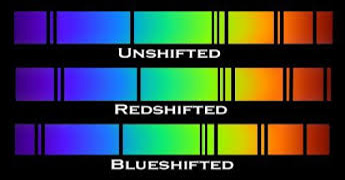The doppler effect is a wave phenomena that occurs when a stationary observer encounters waves produced from a moving source. As the the moving wave source approaches the observer, the frequency of the wave produced by the moving source is observed to be higher than if the wave source was stationary. Also, as the moving wave source moves away from the stationary observer, the observed frequency is less.
A car passing by a pedestrian is probably the most common of the doppler effect. Whether the car's engine is the only thing producing sound or the car's horn is engaged, the stationary pedestrian "observer" will hear a high frequency sound as the vehicle approaches followed by a lower frequency sound as it departs. Hear It
Procede through the activities below to explore the doppler effect.
Set-up: After Java doesn't run, scroll down a little and click "Java Application". After it downloads, run it ("Open" in Internet Explorer, or in Chrome, click on the download at the bottom of the browser). Reposition the simulation window over the Activity space to the right.
The growing circles represent sound wave "compression" areas or wave crests as the sound from the siren travels away from the ambulance. Just because the ambulance is moving does not mean the waves "move" along with it. Waves travel from the point in space where they are created, and can only move as fast as the medium they are travelling through will allow them; in this case, sound travels through the air, so sound is limited to moving as fast as sound travels in the air. Sound travels at about 770 mi/hr through air, but even if the ambulance is moving at 30 mi/hr, sound will still travel outward from its source at 770 mi/hr. It will not travel at 800 mi/hr just because the ambulance is moving.
Make observations and record your responses to this activity in the box below.
The moving object represents a moving sound source traveling at Mach 0.43. If the dot is an aircraft, that means that it is traveling at 43% of the speed of sound. (The speeds at the bottom of the screen represent 10s of miles per hour; the speed of sound is roughly 700 miles per hour, so if the aircraft is set at 30, then its speed is 300 mph. 300/700 = Mach 0.43)
The growing circles eminating from the sound source, as in Activity 1, represent wave fronts. This simulation allow us to see how aircraft approaching the speed of sound create an intense "wall" of compressed air that is commonly called the sound barrier.
Introduction:
In this simulation, the top wave is produced by a wave source, and the bottom wave is what the observer of the wave receives. The wave could represent not only sound, but also light.
Doppler Effect on light - Redshift and Blueshift:
Activities 1 and 2 are based on waves created in the air through compressions, called longitudinal waves. The wave "fronts" represented the highly compressed regions of air as sound was produced and traveled through the air. In this activity, you are given a view of transverse waves and how they travel after being emitted by moving and stationary sources.
Light has wave-like properties that can be describe using transverse waves. Studying light waves from stars, galaxies, and other formations is the only way astrophysicists can discover information about them. In particular, by looking at the wavelengths of light emitted by a star, scientist is able to observe redshift and blueshift. Redshift and blueshift are the result of the Doppler effect applied to light waves. If light from a particular star is redshifted, the observed wavelengths of light are greater than they should be, making the light appear more toward the red end of the visible light spectrum. If light from a particular star is blueshifted, the observed wavelengths of light are less than they should be, making the light appear more toward the blue end of the visible light spectrum:

Observe the ambulance and the sound waves produced. Look closely at how the waves hit the observer as the ambulance approaches, and as the ambulance passes and departs.
Move the source away from the observer. This would be an example of how redshift is created.
